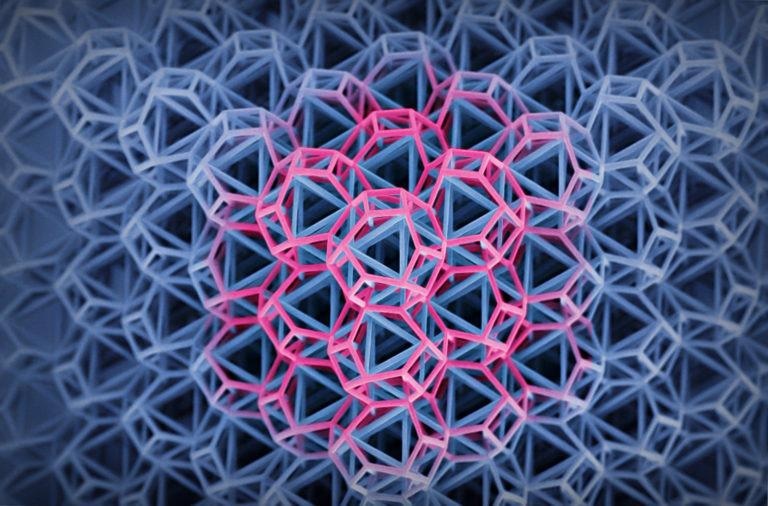Mar 12 2021
A chain reaction of locally restricted damage can inevitably lead to a catastrophic breakdown of structures and materials. Such a failure can be seen in many structures, from metal space trusses that collapse after the warping of a solo strut to solid ceramics that breakdown after the development of a tiny crack.
 Novel tensegrity metamaterials by UCI and Georgia Institute of Technology researchers employ isolated compressive loop elements that are exclusively connected through a continuous network of tensile members (highlighted in magenta). Image Credit: Jens Bauer and Cameron Crook/University of California, Irvine.
Novel tensegrity metamaterials by UCI and Georgia Institute of Technology researchers employ isolated compressive loop elements that are exclusively connected through a continuous network of tensile members (highlighted in magenta). Image Credit: Jens Bauer and Cameron Crook/University of California, Irvine.
In a new study recently published in the Advanced Materials journal, engineers from the University of California, Irvine and the Georgia Institute of Technology have explained the development of a new range of mechanical metamaterials that prevent failure by delocalizing the deformations.
The researchers achieved this feat by focusing on tensegrity—a 100-year-old design principle—wherein separated rigid bars are incorporated into a flexible web of tethers to create self-tensioning and extremely lightweight truss structures.
Beginning with members, which measure 950 nm in diameters, the researchers utilized an advanced direct laser writing method to produce elementary cells, whose size ranged from 10 to 20 µm. These members were constructed into eight-unit supercells that can be organized with other members to create a continuous structure.
The team subsequently performed laboratory experiments and computational modeling and discovered that the constructs displayed an exceptionally uniform deformation behavior without any localized underuse or overstress.
The researchers ultimately demonstrated that the novel metamaterials have a 25 times improvement in deformability and also an orders-of-magnitude improvement in energy absorption over advanced lattice arrangements.
Tensegrity structures have been studied for decades, particularly in the context of architectural design, and they have recently been found in a number of biological systems. Proper periodic tensegrity lattices were theoretically conceptualized only a few years ago by our co-author Julian Rimoli at Georgia Tech, but through this project, we have achieved the first physical implementation and performance demonstration of these metamaterials.
Lorenzo Valdevit, Study Senior Co-Author and Professor, Department of Materials Science and Engineering, University of California, Irvine
Valdevit guides the Architected Materials Group.
While the research team from Georgia Tech was designing structural configurations for planetary landers, they found that tensegrity-based vehicles can resist buckling or severe deformation of their separate components without breaking down, something that was never seen in other structures before.
“This gave us the idea of creating metamaterials that exploit the same principle, which led us to the discovery of the first-ever 3D tensegrity metamaterial,” elaborated Rimoli, an aerospace engineering professor at Georgia Tech.
Extremely lightweight yet rigid and rugged traditional structures based on micrometer-scale lattices and trusses are made possible by new additive manufacturing methods.
Such structures have attracted a great deal of interest from engineers for their ability to substitute heavier, solid substances in wind turbine blades, aircraft, and many other applications.
While these sophisticated materials have several desirable qualities, they can still be vulnerable to serious destruction if overloaded, just like other load-bearing structures.
In familiar nano-architected materials, failure usually starts with a highly localized deformation. Shear bands, surface cracks, and buckling of walls and struts in one area can cause a chain reaction leading to the collapse of an entire structure.
Jens Bauer, Study First Author and Research Scientist, Department of Mechanical and Aerospace Engineering, University of California, Irvine
Bauer explained that truss lattices start to break down when compressive members buckle, since those in tension cannot do so. Generally, such components are interlinked at common nodes, which means that once a component fails, damage can rapidly spread across the whole structure.
On the other hand, the compressive members of tensegrity architectures create closed loops, which are separated from each other and are simply linked by tensile members. The instability of compressive members can, therefore, only spread through tensile load paths, which cannot sustain instability, particularly if they do not rupture.
Push down on the entire structure and a tensegrity system compresses evenly, avoiding localized impairment that would otherwise lead to serious failure.
According to Valdevit, who is also a professor of mechanical and aerospace engineering at the University of California, Irvine, tensegrity metamaterials have an unparalleled combination of strength, deformability, extreme energy absorption and failure resistance, superseding all other kinds of advanced lightweight architectures.
This study provides important groundwork for design of superior engineering systems, from reusable impact protection systems to adaptive load-bearing structures.
Lorenzo Valdevit, Study Senior Co-Author and Professor, Department of Materials Science and Engineering, University of California, Irvine
The study also included Julie Kraus, a graduate student in the Rimoli laboratory at Georgia Tech, and Cameron Crook, a graduate student in materials science and engineering from the University of California, Irvine. NASA and the National Science Foundation have funded the study.
Video Credit: University of California, Irvine.
Journal Reference:
Bauer, J., et al. (2021) Tensegrity Metamaterials: Toward Failure‐Resistant Engineering Systems through Delocalized Deformation. Advanced Materials. doi.org/10.1002/adma.202005647.